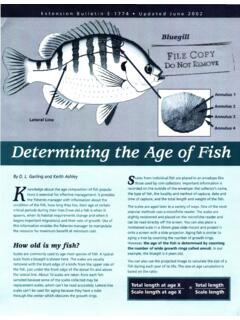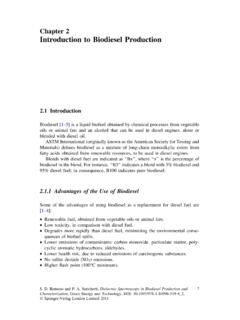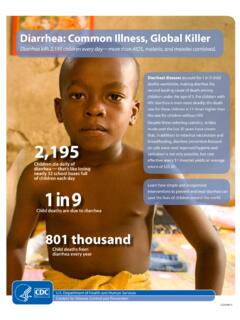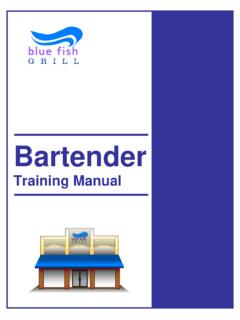Transcription of Food Safety Systems - College of Agriculture & Natural ...
1 Supported by: Food Safety Systems Prerequisite Programs and Validation Prepared by Robert Culler, Culler Consulting, LLC Tina Conklin, Food Processing Specialist Product Center Food Ag Bio Michigan State University Date March 2015 Acknowledgement Funding for the project was provide by the Michigan Department of Agriculture and Rural Development Food Safety Systems , Prerequisite Programs and Validation 2 | Page Table of Contents I. sanitation Standard Operating A. sanitation B. Pre-operational Inspection C. Operational Inspection II. Allergen Control III. Customer Complaint IV. Employee Hygiene and V. Employee Training / VI. Equipment A. pH meter B. Thermometer VII. Facility Condition and VIII. Food Defense / Product Tampering / Crisis IX. Foreign Object A. Glass, Brittle Plastic and Ceramic Materials B. Metal Materials X. Ingredient Control, Traceability and Lot A.
2 water B. Raw Materials and Ingredients C. Traceability D. Lot Coding XI. Label XII. Laboratory A. Internal B. Outside C. Documentation XIII. Letters of XIV. Lock-out / Tag-out Food Safety Systems , Prerequisite Programs and Validation 3 | Page XV. A. Preventative B. Temporary Repairs C. Lubricants and Nonfood Compounds XVI. Microbial & Chemical A. Raw Material (Harvest anti-microbial, Pathogens, Chemical Residues) B. Pathogen Control C. Test and Hold Policy (Internal & Regulatory Sampling) XVII. Net Weight XVIII. Pest Prevention XIX. Product Withdrawal / XX. Returned Product XXI. Scale XXII. Shelf XXIII. XXIV. Suppliers A. Specifications and Certificates B. Approval Program XXV. A. Internal Audits B. Document Control 1. Records and Retention 2. Product Change / Amendment Food Safety Systems , Prerequisite Programs and Validation 4 | Page Introduction During the preparation and processing of food products there are many aspects to assure that the item is wholesome, safe and not adulterated.
3 "Adulteration" is a legal term meaning that a food product fails to meet federal or state standards. Adulteration usually refers to noncompliance with health or Safety standards as determined, in the United States, by the Food and Drug Administration (FDA) and the Unites States Department of Agriculture (USDA). The backbone of any Food Safety System is Hazard Analysis and Critical Control Points (HACCP). HACCP is a systematic preventive approach to food Safety from biological, chemical, and physical hazards in production processes that can cause the finished product to be unsafe, and designs measurements to reduce these risks to a safe level. In this manner, HACCP is referred as the prevention of hazards rather than finished product inspection. Meat and poultry HACCP Systems are regulated by the USDA, while seafood and juice are regulated by the FDA. The use of HACCP is becoming mandatory under the Food Safety Modernization Act (FSMA) for other food industries.
4 HACCP itself was conceived in the late 1960s when the US National Aeronautics and Space Administration (NASA), US Army Natick Laboratories and Pillsbury collaborated to design a food Safety tool to manufacture the first foods for space flights. It was, however, recognized that HAACP by itself does not provide the complete food Safety system. For a complete food Safety system, HACCP is supported by numerous programs that are generally referred to as prerequisite programs . Depending on the industry other names for prerequisite programs are Good Manufacturing Practices (GMP s), Standard Operating Procedures (SOPs), Preventative Maintenance Program, etc. The goal of this document is to identify the various prerequisite programs and explain their purpose. Food Safety Systems , Prerequisite Programs and Validation 5 | Page I. sanitation Standard Operating Procedures A. sanitation The sanitation program identifies the routine and special / deep cleaning of the entire facility.
5 The basis for sanitation is the removal of soils from the manufacturing environment. There are many benefits to this process. From a food Safety standpoint, there is the removal of pathogenic organisms, prevention of the formation of biofilms and removal of potentially harmful chemicals from food contact surfaces. From a quality standpoint, there is removal of spoilage organisms to improve the shelf life of refrigerated or ambient product and decrease the opportunities for spoilage. sanitation is also used to prevent cross-over of residue from different animal species as well as preventing flavor impact by cross-over of spices and flavorings. Improved sanitation performance can also increase productivity by facilitating efficient processing start-up. Microbiological contaminants of concern can depend on the type of product and the process through which the product passes. Pathogenic bacteria have been associated with human foodborne illness.
6 They can result in consumer sickness, hospitalization, fatality, recall, liability and loss of business. For this reason, they are of great concern to the consuming public, the food industry and the regulatory agencies. Specific pathogenic organisms that have been most often associated with illness are Listeria monocytogenes, Salmonella and E. coli O157:H7. The primary pathogen of concern for sanitation , particularly in ready-to-eat meat and poultry operations, is L. monocytogenes as it is a ubiquitous organism, meaning it can be found frequently throughout the environment and can grow under a wide range of conditions in food plants. Salmonella and E. coli O157:H7 are not generally considered environmental contaminants; however, they are organisms that need to be removed from the environment. Contamination of food products with spoilage microorganisms that do not result in foodborne illness, however, may be the underlying cause for reduction in shelf life of food products.
7 While these organisms is easily eliminated through cooking, they are responsible for spoilage of product in the ambient shelf or refrigerated state. Spoilage organisms include yeast, mold, Lactobacillus, Pseudomonas and rope spores. These are all removed by effective cleaning and sanitation . One of the great challenges that face the sanitation team is the formation of biofilms on food equipment surfaces. Food manufacturing plants have recognized that biofilms can have a profound impact on the Safety and quality of their products. Their formation has the potential to contaminate product through the introduction of pathogenic microorganisms or spoilage bacteria. They are difficult to remove once they mature as they are resistant to normal sanitation procedures and can result in other detrimental process effects. Even when a food surface appears to be clean, the presence of biofilms is a potential hazard that must be eliminated and prevented from reoccurring.
8 Biofilms begin with a conditioning layer of organic (protein) or inorganic matter forming on an otherwise visually clean food contact surface. The accumulation of organic and inorganic material on processing surfaces creates an environment to which bacteria can adhere. As the layers of bacteria attach to the surface and each other, they trap debris and nutrients and the biofilm begins to take shape. Development and growth, without removal, results in the film becoming irreversibly attached to a substratum or interface Food Safety Systems , Prerequisite Programs and Validation 6 | Page or to each other. Biofilms form at a slow but steady rate and become harder to remove over time. They are most likely to form on rough, penetrable surfaces but can also form on just about any surface. Fortunately, the original biofilm attachment is weak and easy to remove through proper sanitation procedures. Therefore, the film soil must be removed and the most effective method process includes a potable water rinse, soap/cleaner application, mild mechanical action to further loosen soil, final potable water rinse and sanitizing.
9 Chemical contaminants of primary concern are allergen proteins. The "Big 8" allergens that are recognized as significant concern for food manufacturers include eggs, soy, wheat, milk, fish, Crustacean, peanuts and tree nuts. Human allergic reactions to foods are the results of sensitivity to the major protein of the food. For example, the primary protein in egg is albumen. These proteins are often left behind as residue on production surfaces during processing. It is important that the sanitation process be rigorous enough to remove the protein from food contact surfaces. Other chemicals that can be removed through the sanitation process include hydraulic oil and lubricants. While plants should use lubricants that are H1 rated (food grade) for incidental contact, it is still important to remove surplus grease that may make its way onto contact surfaces from over-lubrication. Physical contaminants may present a lesser challenge for the sanitation crew but should still be recognized.
10 In grinding, chopping and mixing operations, there is always the possibility that metal shavings or fragments may be left on surfaces due to metal-to-metal contact. The sanitation process may be able to remove these fragments before they enter the product or the product stream. In addition, particles of meat, dough or starch that may form during manufacturing may also be removed during the sanitation process, preventing hardened material that can pose a dental hazard. The sanitation program needs to include facility area / room and items that will be cleaned after production processes: Facility areas include: Exterior and grounds, Receiving, Production (raw, spice, ready-to-eat), storage (raw, work-in-process, finished), employee welfare, break / lunch, offices, etc. Listing of food contact equipment, utensils, and containers; facility equipment, such as, hand wash sinks, trash and inedible containers, etc.; facility structures including walls, floors, ceilings, cooling units, piping and drains.












